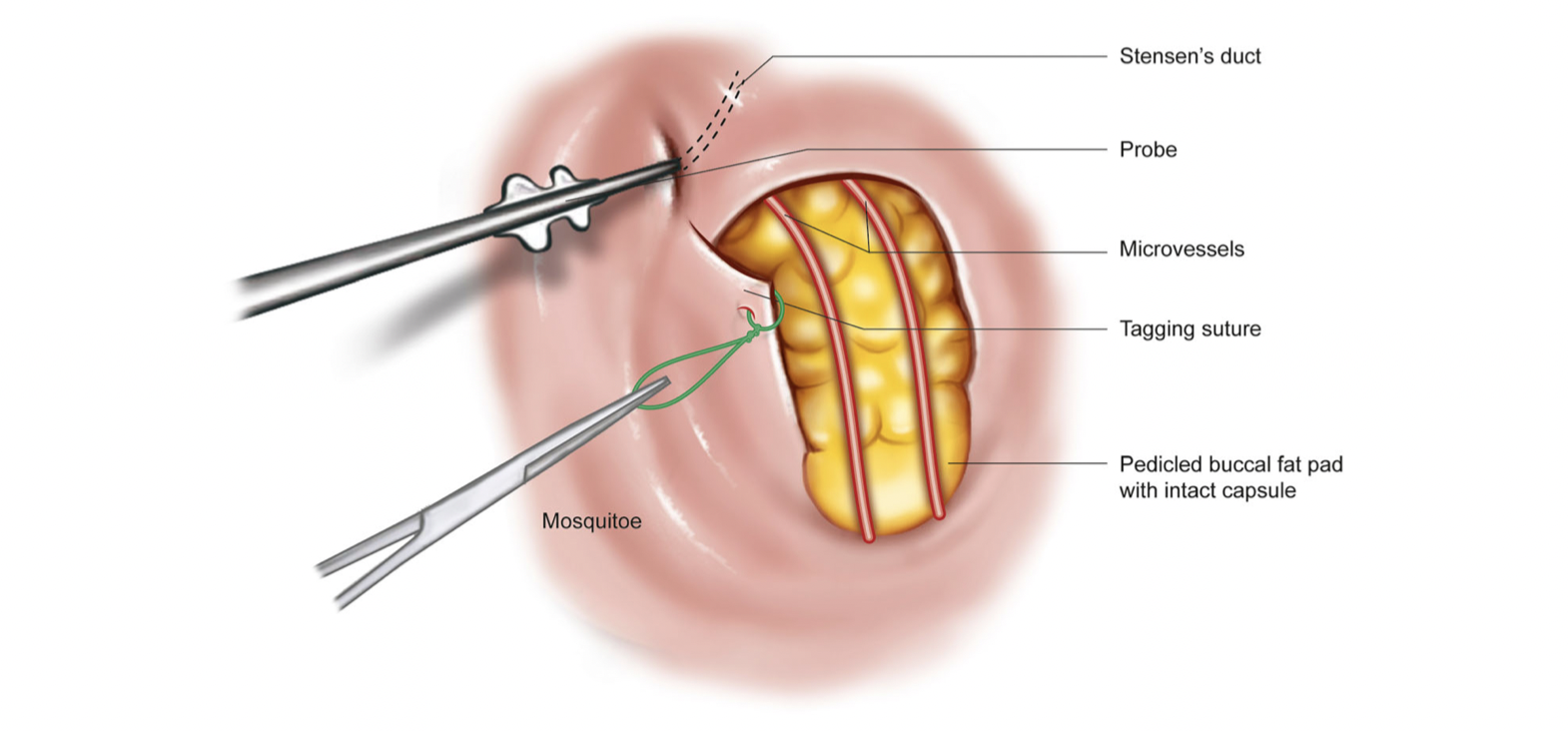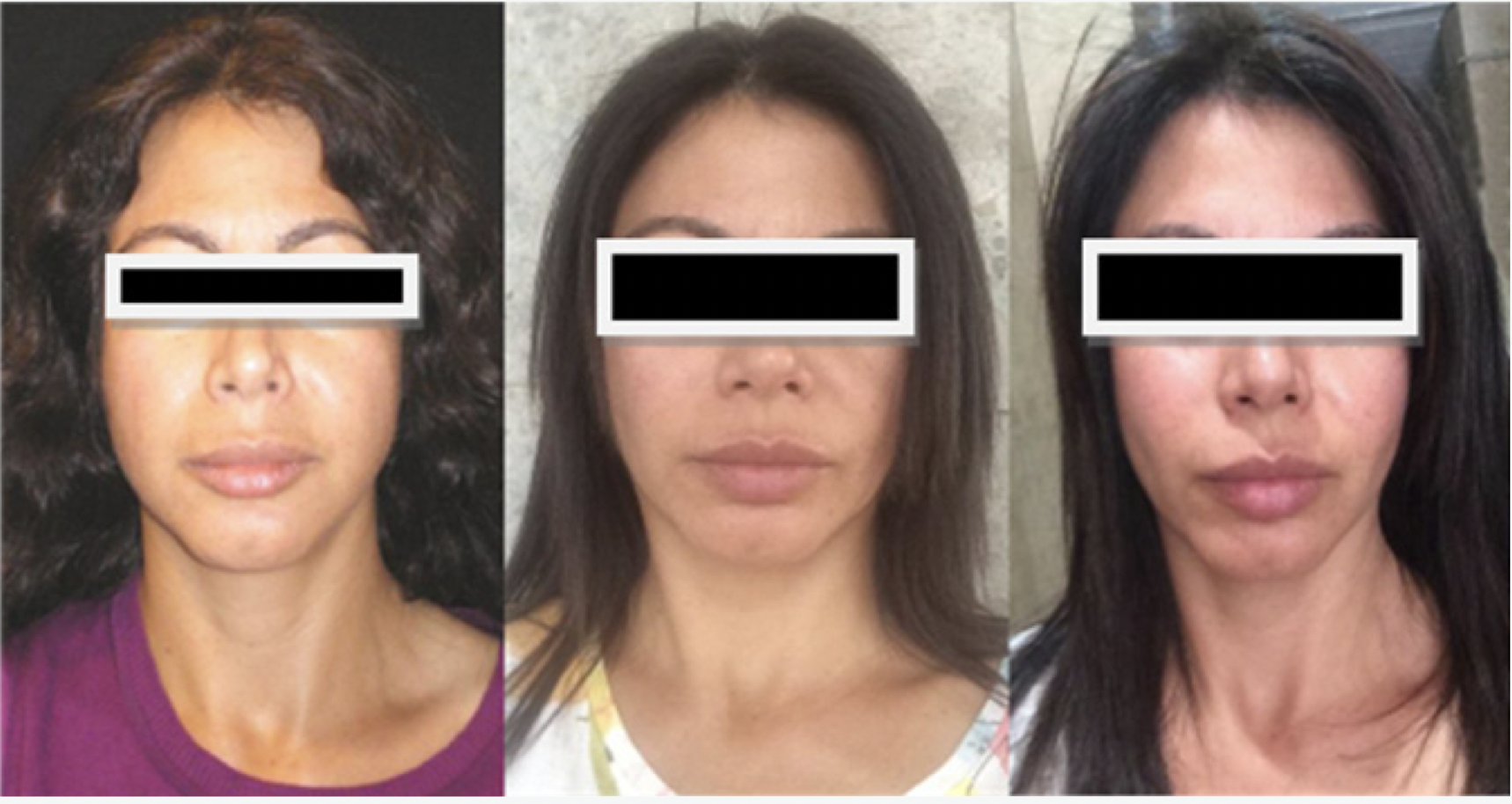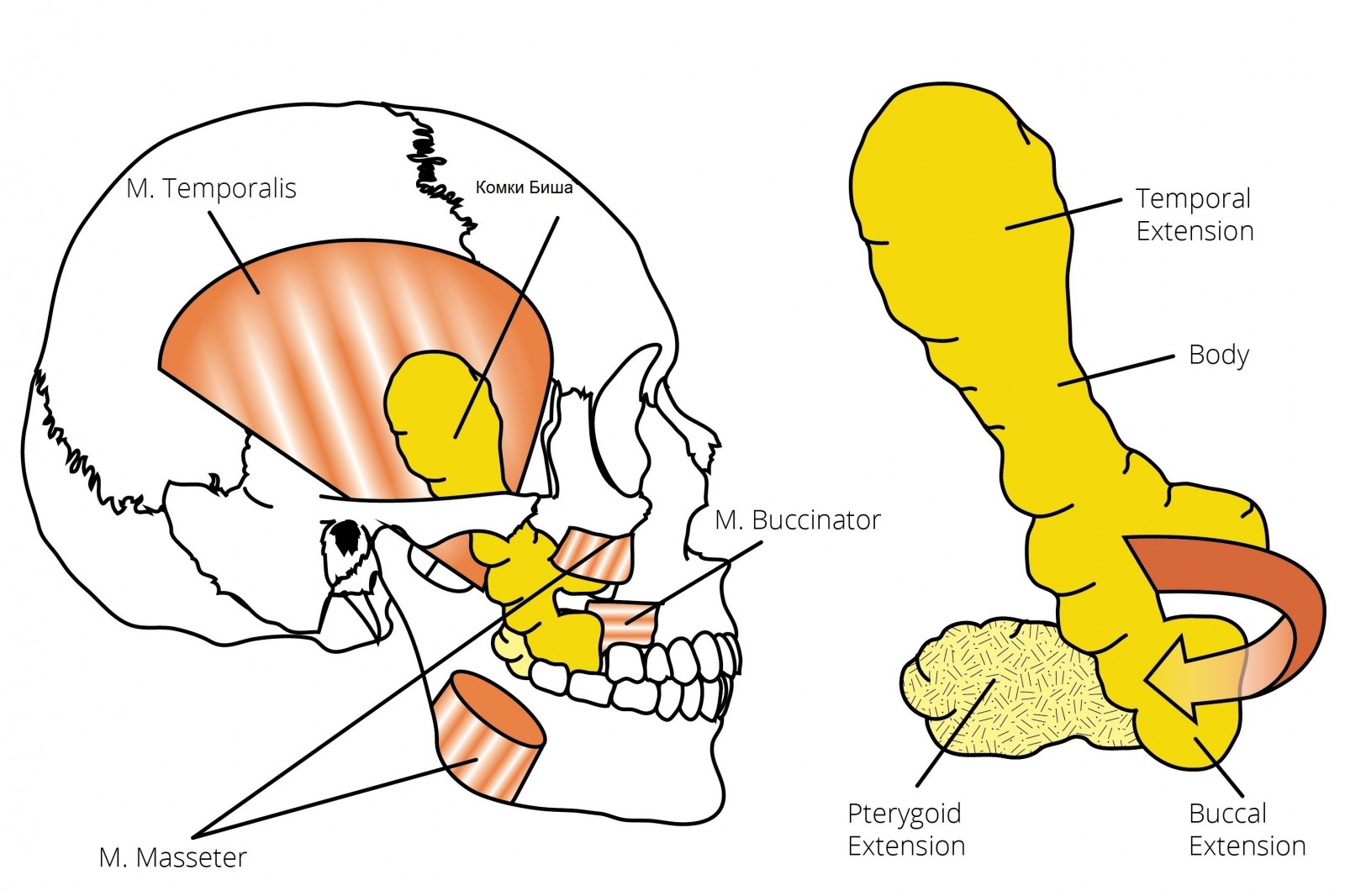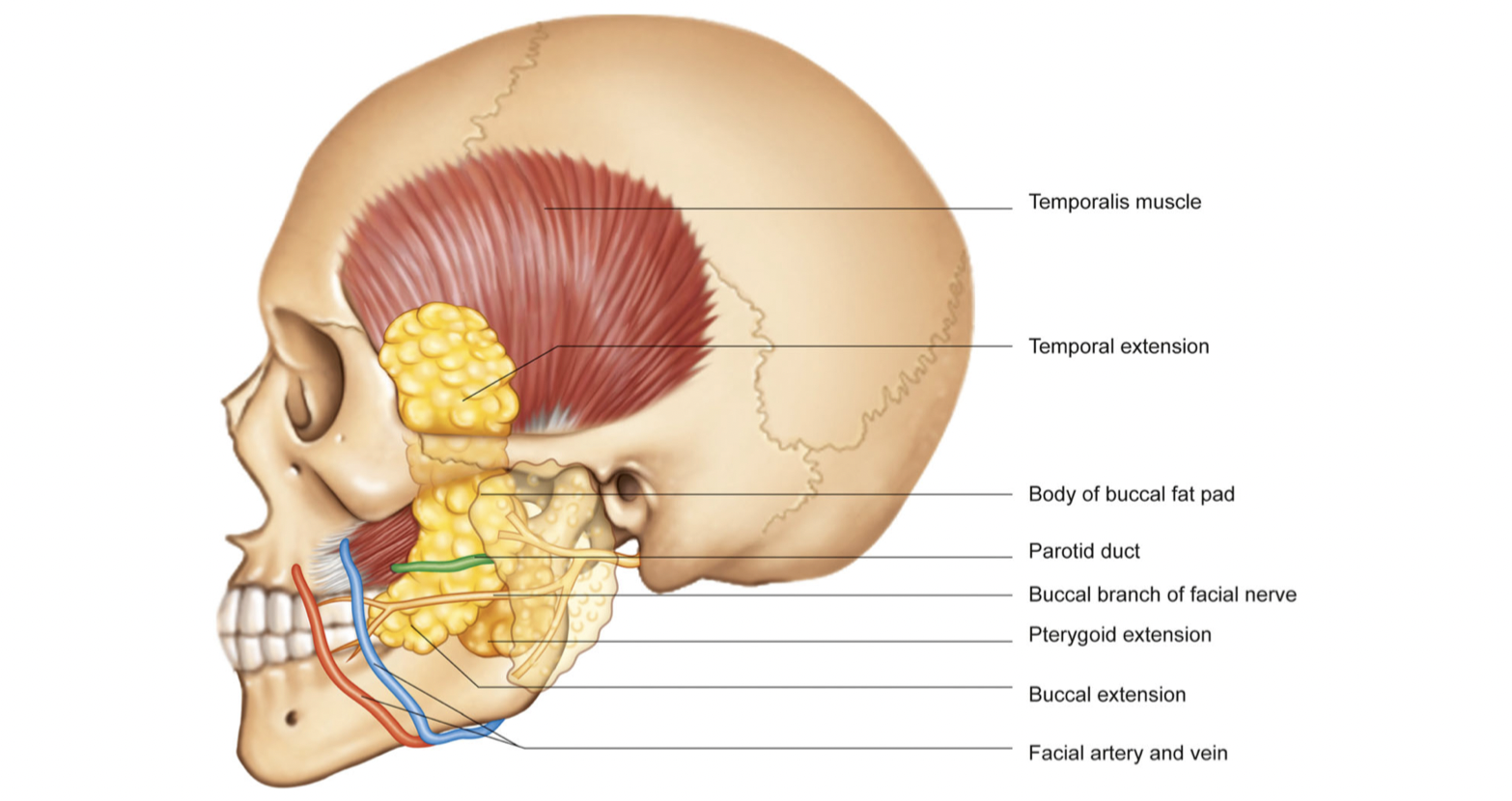Bisha's lumps: what are they and is it safe to remove them?
Pronounced cheekbones and jawline have always been a desired result of facial correction procedures among patients regardless of gender, status and age. In this regard, a method with a striking “thin face” effect appeared - bishectomy. Let's talk about the feasibility and outcomes of this intervention.
Kristina Filevich , editor of Pro Cosmetology BHUB
What are “Bisha lumps”?
Bichat's fat pads ( Bichat's fat pads; Buccal Fat Pads ) - encapsulated fatty formations in the cheek area. Anatomically, they are located bilaterally between the buccal muscle and the superficial muscles of the face - the masseter, zygomaticus major and zygomaticus minor.
Anatomically, Bisha's lumps have a body, which is in projection, as well as 4 expanded parts - temporal, buccal, pterygoid and pterygopalatine. These fatty structures are divided into small lobes using connective tissue septa.
Rice. 1 Anatomical structure of Bichat's lumps [1]
Near the lumps there are important formations - the excretory duct of the parotid salivary gland (Stensen's duct), which passes through the buccinator in the anterior part of the lump, the branches of the buccal branch of the facial nerve, the facial artery and vein. (Fig. 2)
The blood supply to Bisha's lumps is carried out using the superior, superficial and deep temporal arteries. Inside the capsule there are rich capillary networks that cover the entire surface of the structure. Most of the blood from the cheek fat pad drains into the facial vein.
Rice. 2: Topographic anatomy and syntopy of Bichat's lumps in an adult. [2]
Functions of buccal fat pads
At the moment there are many assumptions about the role of Bisha's lumps. These formations are very important for children and infants to carry out the act of chewing and sucking and, accordingly, for the formation of anatomically correct structures of the oral cavity and the development of facial muscles. With age, the lumps involute.
In an adult, fat bodies act as a shock absorber in the chewing mechanism, facilitating the work of the joint-ligamentous and muscular apparatus of the face, and also protect anatomically important structures from injury.
Aesthetic function
Some people have peculiarities in the development and placement of adipose tissue, when Bisha's lumps are too pronounced and give the lower third of the face a more rounded and massive appearance. Hypertrophy, or too superficial localization, of the buccal fat bodies can also be associated with a congenital structural feature of the oral cavity and dental pathologies - pathological types of occlusion, bruxism, the use of braces, dentures, various diseases of the teeth, salivary glands, temporomandibular joints.
Bishectomy
Considering the ever-current beauty trends for clear and expressive facial features, the procedure for surgical removal of Bisha's lumps, also known as bishectomy , has gained particular popularity over the past couple of years.
The expected effect of the operation is a more emphasized oval of the face, expressive cheekbones, tightening of the structures of the lower and middle third of the face.
The removal procedure itself is minimally invasive : access is made through the mucous membrane of the cheek.

Rice. 3: Technique for surgical removal of the buccal part of Bichat's lump [2]
In addition to aesthetic indications, bishectomy can also be performed for the purpose of further use of lumps for the plastic closure of oral defects [2] or, in cases of diseases affecting these fatty structures (benign and malignant tumors) [3]. Oral fat flaps use a mechanism of lipolysis that is different from that of subcutaneous adipose tissue, so the age and gender of the patient do not affect the results of the technique [4].
Results of removing Bisha's lumps
The effect primarily depends on the characteristics of fat deposition on the face. It is more expressive in patients with a rounder face type, which is visualized due to the excessive development of the buccal part of the lump.
Before performing a bishectomy, it is important to collect the patient’s medical history, including dental history, take into account the presence of contraindications to surgical interventions, and prescribe imaging methods for studying the anatomical features of facial structures.

Rice. 4: Patient before and after bishectomy; 1 photo – before the intervention; 2 photos – 2 months. after bishectomy; 3 photos – 4 months. after bishectomy [5]
It would seem that a little jewelry work from a plastic surgeon and beautiful, clear, protruding cheekbones are guaranteed! But, unfortunately, not all patients have a guarantee of the expected result. It is also worth remembering that bishectomy, like all other invasive procedures, can have a number of unpleasant consequences and complications, including long-term ones.
Contraindications for removing Bisha's lumps
Absolute contraindications:
- diabetes;
- acute chronic diseases;
- obesity or too low weight, planned serious weight change;
- acute inflammation in the oral cavity;
- oncological diseases, as well as connective tissue dysplasia;
- bleeding disorders;
- mental illness.
Relative contraindications:
- The patient's age is less than 25 years: before this age, the facial skeleton is still developing. Too early intervention threatens structural pathologies of the bone, muscle, and joint-ligamentous apparatus.
Possible complications
Injuries to the buccal branch of the facial nerve: damage to the motor and sensory endings, which leads to segmental disorders (partial paralysis, loss of deep and superficial sensitivity, impaired salivation, including xerostomia, loss or distortion of taste).
Parotid duct injury: Can occur in patients whose parotid ducts extend deep into the buccal fat pad. This can lead to a salivary fistula, sialocele, sialoadenitis, including calculous forms and mumps [6].
Secondary infection: as with any invasive intervention, the risk of infection of facial structures remains quite possible with the development of purulent inflammatory processes of soft tissues and salivary glands.
Consequences in old age
It is worth considering that age-related gravitational changes in the face can have adverse long-term consequences in old age. Excessive downward movement of Bisha's lumps can lead to excessive loss of volume in the middle third of the face, as well as to pronounced gravitational ptosis of the structures. The risk of such an effect depends on the individual characteristics of the patient’s body, as well as on the course and consequences of the operation itself.
Whether or not to remove Bish's lumps is everyone's choice. The task of a specialist in the field of aesthetic medicine is to clearly inform his patient about all possible outcomes of the technique, as well as to help in the process of preparation and rehabilitation.
Bibliography:
[1] http://www.bodysculptor.com/face/buccal-fat-extraction/
[2] Kim, M. K., Han, W., & Kim, S. G. (2017). The use of the buccal fat pad flap for oral reconstruction. Maxillofacial Plastic and Reconstructive Surgery, 39(1). https://doi.org/10.1186/s40902-017-0105-5
[3] Dubin, B., Jackson, I. T., Halim, A., Triplett, W. W., & Ferreira, M. (1989). Anatomy of the Buccal Fat Pad and Its Clinical Significance. Plastic and Reconstructive Surgery, 83(2), 257–262. https://doi.org/10.1097/00006534-198902000-00009
[4] FARIA, CADC, DIAS, RCS, CAMPOS, AC, DAHER, JC, COSTA, RSC, & BARCELOS, LDP (2018). Bichectomy and its contribution to facial harmony. Revista Brasileira de Cirurgia Plástica (RBCP) – Brazilian Journal of Plastic Sugery, 33(4), 446–452. https://doi.org/10.5935/2177-1235.2018rbcp0164
[5] Lima Stevao, E. L. D. (2015). Bichectomy or Bichatectomy - A small and simple intraoral surgical procedure with great facial results. Advances in Dentistry and Oral Health, 1(1). https://doi.org/10.19080/adoh.2015.01.555555
[6] Hwang, K., Cho, H. J., Battuvshin, D., Chung, I. H., & Hwang, S. H. (2005). Interrelated Buccal Fat Pad With Facial Buccal Branches and Parotid Duct. Journal of Craniofacial Surgery, 16(4), 658–660. https://doi.org/10.1097/01.scs.0000157019.35407.55
Read also
- National platform "Anatomy of Beauty" 3.0: a separate room dedicated to the work of plastic surgeons
- ICAMPS 2025: modern principles of reconstructive and plastic surgery
- ICAMPS 2024: Reconstructive Surgery, Recovery and Support for Ukraine's Defenders
- The choice between minimally invasive techniques and radical surgery
- Beauty tandem: plastic surgeon and cosmetologist
- Aesthetic mammoplasty: common surgical complications
- Lipofilling: volumizing possibilities of the procedure
- Postoperative care in the practice of an aesthetic medicine specialist
- Physiotherapy methods of recovery after plastic surgery
- Lumps of Bisha


